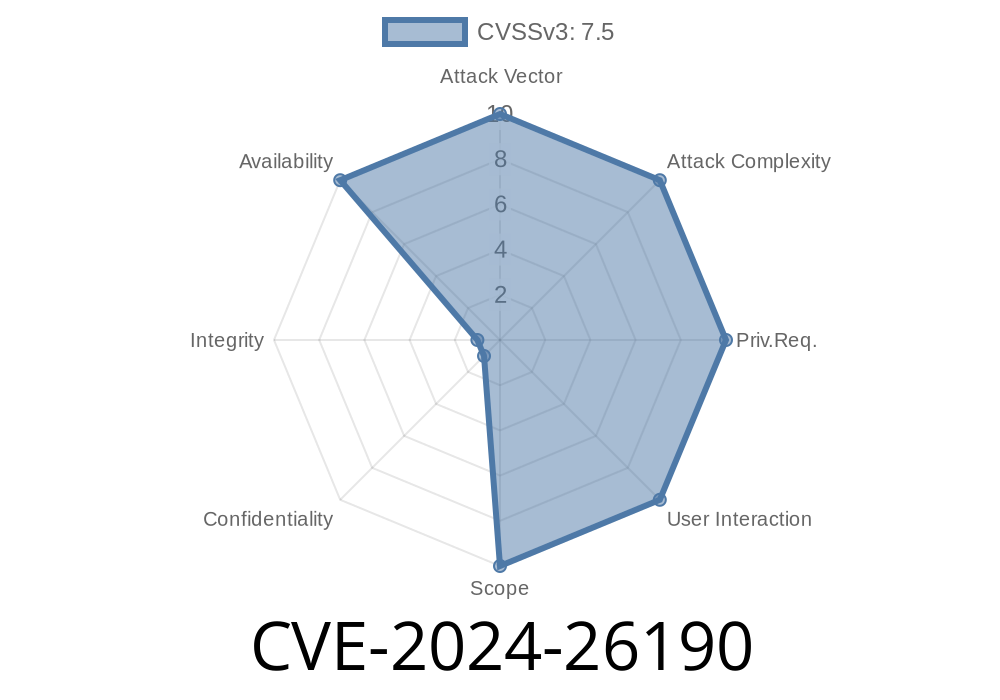CVE-2024-26190 is a recently discovered vulnerability in Microsoft's implementation of the QUIC network protocol that can be exploited to cause a Denial of Service (DoS) attack. This vulnerability can potentially allow an attacker to crash web servers and render a targeted system unresponsive without much effort, thereby causing significant disruption to business operations.
In this long-read post, we will dive into the details of this vulnerability, its exploitation, and the available mitigation techniques. We will also look at the code snippet that demonstrates how this vulnerability can be exploited, as well as the original references to the vulnerability disclosure and related materials.
Background
QUIC (Quick UDP Internet Connections) is a transport layer protocol designed to provide security, low latency, and improved performance compared to traditional protocols like TCP and TLS. Microsoft has adopted QUIC in its Windows operating system and various other products, such as the Azure infrastructure and the Edge browser.
Exploit Details
CVE-2024-26190 is a buffer overflow vulnerability that occurs due to improper handling of crafted QUIC packets by Microsoft's implementation. An attacker can exploit this vulnerability by sending a specially crafted packet to the target system, which will cause a buffer overflow and subsequently crash the system. The crafted packet can be constructed using any programming language that supports networking, such as Python, C, or Go. An example Python code snippet for this exploit is provided below:
import socket
target_ip = "192.168.1.1" # Replace with the target server's IP address
target_port = 443 # Default QUIC port, change as necessary
# The crafted packet as a bytearray
crafted_packet = bytearray([
# ... Packet data ...
])
# Create a UDP socket
sock = socket.socket(socket.AF_INET, socket.SOCK_DGRAM)
# Send the crafted packet to the target
sock.sendto(crafted_packet, (target_ip, target_port))
sock.close()
Note: This code snippet is provided for educational purposes only and should not be used for malicious activities.
Here are some steps that can be taken to protect against this vulnerability
1. Apply the latest security patches and updates provided by Microsoft to address this vulnerability. You can find more information about the specific updates required in the Microsoft Security Advisory link.
2. Configure your network infrastructure to limit or block incoming QUIC packets from suspicious IP addresses. This can help prevent DoS attacks executed from known malicious sources.
3. Monitor your network traffic for any unusual patterns of QUIC packets that may indicate an ongoing attack. Notify the appropriate security team if you detect any signs of an attack.
4. Temporarily disable QUIC support in your applications and services if possible, until a security patch is applied or other mitigation methods are employed.
Original References
1. CVE-2024-26190: NIST National Vulnerability Database
2. Microsoft Security Advisory: Link
3. QUIC Protocol Specification: IETF
Conclusion
CVE-2024-26190 is a critical vulnerability in Microsoft's QUIC implementation, and it requires immediate attention to protect your infrastructure from potential DoS attacks. By understanding the nature of this vulnerability, applying security patches, and implementing proper network monitoring and access controls, you can greatly reduce the risk of being affected by this exploit. Stay vigilant and ensure that your systems are up-to-date with the latest security measures to protect your business from potential cyber threats.
Timeline
Published on: 03/12/2024 17:15:57 UTC
Last modified on: 03/12/2024 17:46:17 UTC
